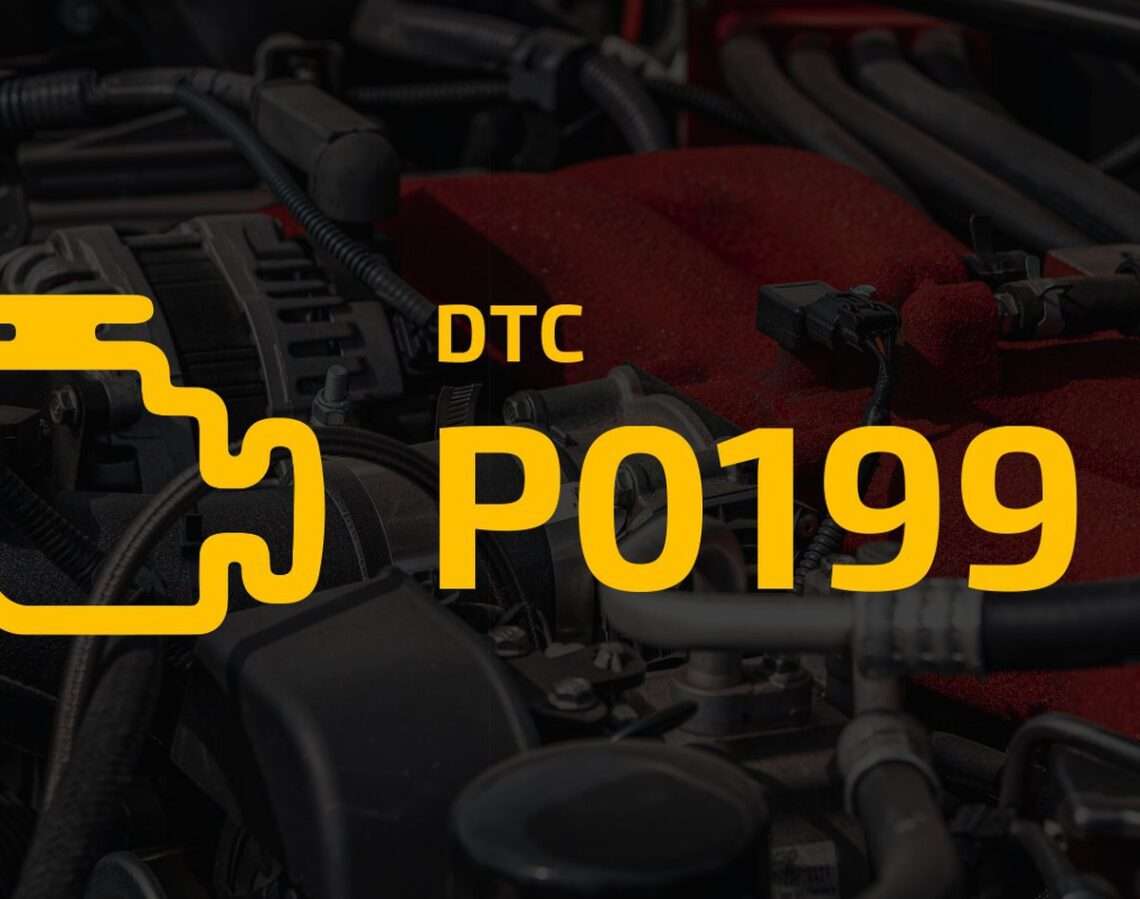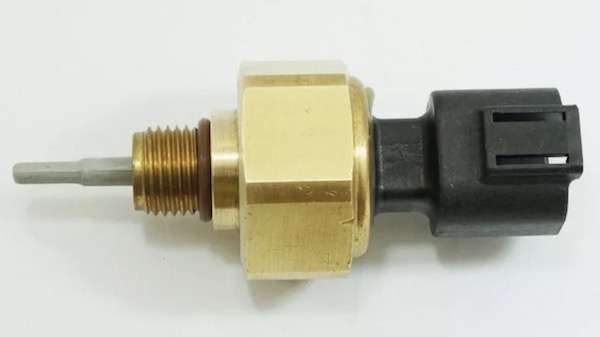
P0199 Intermittent signal in the engine oil temperature sensor circuit
Content
P0199 – OBD-II Trouble Code Technical Description
Trouble code P0199 indicates an intermittent signal in the engine oil temperature sensor circuit. DTCs may also appear at the same time as this DTC. P0195, P0196, P0197 и P0198.
What does the fault code mean P0199?
Trouble code P0199 indicates an engine operating problem due to the engine oil temperature sensor receiving an incorrect signal. When this DTC occurs, the engine control module (ECM) can put the vehicle into limp mode to prevent further damage. The vehicle will remain in this mode until the cause of the malfunction is eliminated.

Possible reasons
Trouble code P0199 can be caused by the following reasons:
- Defect or malfunction of the engine oil temperature sensor.
- Damaged or broken wiring between the oil temperature sensor and the engine control module (ECM).
- Incorrect connection or failure in the electrical circuit between the sensor and the ECM.
- The engine oil level is low or contaminated, which may affect the accuracy of the temperature measurement.
- Problems with the engine control module (ECM) itself, such as a software error or damage.
What are the symptoms of a fault code? P0199?
Symptoms that may occur with DTC P0199:
- Engine performance deterioration: The car may lose power or respond more slowly to the gas pedal due to incorrect engine oil temperature readings.
- Unstable engine operation: Engine rattling or shaking may occur due to improper operating conditions caused by erroneous oil temperature data.
- Difficulty starting: Low oil temperatures may make it difficult to start the engine because the system may not interpret the temperature data correctly.
- Check Engine Light (CEL) Illumination: When P0199 is detected, the engine management system activates the Check Engine Light on the instrument panel to indicate a problem.
- Limitation of engine operating mode: In some cases, the engine management system may put the vehicle into limp mode, limiting maximum RPM or speed to prevent possible damage.
How to diagnose a fault code P0199?
To diagnose DTC P0199, you can do the following:
- Scanning error codes: Use an OBD-II scanner to read error codes. Make sure the P0199 code is indeed present and check for other possible error codes.
- Checking the oil temperature sensor: Check the condition and correct installation of the oil temperature sensor. Make sure it is not damaged and connected correctly.
- Wiring check: Inspect the wiring connecting the oil temperature sensor to the engine control module (ECM) for damage, breaks, or corrosion. Correct any problems found.
- Checking the oil level and condition: Check the engine oil level and condition. If the level is too low or the oil is too dirty, the accuracy of the temperature measurement may be affected.
- ECM Check: If the previous steps do not reveal a problem, the engine control module (ECM) itself may be faulty. However, this requires more advanced diagnostics and may require referral to professionals.
- Real-time system testing: If necessary, perform real-time testing of the system to verify its performance under different operating conditions, such as different engine temperatures.
If you do not have experience in diagnosing automotive systems, it is recommended that you contact a professional mechanic or auto repair shop for more accurate diagnosis and repair.
Diagnostic errors
When diagnosing DTC P0199, the following errors may occur:
- Skip sensor check: Some technicians may skip checking the condition and proper installation of the oil temperature sensor, thinking it is a less likely source of the problem.
- Incorrect interpretation of scan results: Interpretation of error codes and scan data may be incorrect, which may result in incorrect diagnosis and repair.
- Neglect of wiring: Some mechanics may skip checking the wiring, which can cause a misdiagnosis, especially if the problem involves broken or corroded wiring.
- Ignoring oil condition: Some technicians may fail to check the level and condition of the engine oil, which can lead to a misdiagnosis, especially if the problem is due to low or contaminated oil.
- Incorrect ECM diagnosis: In rare cases, the problem may be related to the engine control module (ECM) itself, but it can be difficult to detect without specialized equipment and experience.
For successful diagnosis, it is necessary to pay attention to all possible sources of the problem and conduct a comprehensive check of all components of the system. It is also important to have experience and professional skills to correctly interpret diagnostic results and make the right repair decision.
How serious is the fault code? P0199?
Trouble code P0199 itself is not critical to driving safety, but it does indicate a problem with the engine oil temperature sensor, which can have serious consequences for engine performance and longevity. If the problem is not resolved, it can lead to poor engine performance, possible damage and even breakdown.
When the P0199 code appears, the engine management system (ECM) may put the vehicle into limp mode to prevent possible damage. This may result in limited engine power or other operating restrictions that may be inconvenient for the driver.
So, although the P0199 code is not an extreme safety concern, it should be taken seriously and it is recommended that steps be taken to resolve it immediately to avoid potential engine performance problems and prevent further damage.
What repair will help eliminate the code? P0199?
Resolving the P0199 trouble code depends on the specific cause. Below are some typical ways to resolve this issue:
- Replacing the oil temperature sensor: If the oil temperature sensor is identified as the cause of the error, it should be replaced with a new and suitable sensor. After replacing the sensor, it is recommended to carry out testing to be sure.
- Checking and replacing wiring: If damage or corrosion is found on the wiring connecting the oil temperature sensor to the ECM, the connection should be replaced or repaired, and the damaged wires should be replaced.
- Checking and cleaning the oil filter system: If the cause of the error is related to low oil level or contamination, then it is necessary to check the level and quality of the engine oil. If the oil is contaminated, it should be replaced, and the condition of the oil filter should be checked and, if necessary, replaced.
- ECM Check and Diagnostics: If the problem is with the ECM, it may require professional diagnosis and possibly ECM replacement or programming.
After repairs are completed, testing and rescanning should be performed to ensure that there are no errors and that the system is operating correctly. If you are unsure of your skills, it is recommended that you contact a qualified mechanic or auto repair shop for diagnosis and repair.
P0199 – Brand-specific information
Trouble code P0199 can occur on various brands of cars, a list of some brands with their meanings:
- Ford: Engine Oil Temperature Sensor Circuit Intermittent/Erratic
- Chevrolet: Engine Oil Temperature Sensor Circuit Intermittent/Erratic
- Toyota: Engine Oil Temperature Sensor Circuit Intermittent/Erratic
- Volkswagen (Volkswagen): Engine Oil Temperature Sensor Circuit Intermittent/Erratic
- BMW: Engine Oil Temperature Sensor Circuit Intermittent/Erratic
- Honda: Engine Oil Temperature Sensor Circuit Intermittent/Erratic
- Audi (Audi): Engine Oil Temperature Sensor Circuit Intermittent/Erratic
- Mercedes-Benz (Mercedes-Benz): Engine Oil Temperature Sensor Circuit Intermittent/Erratic
These are just a few examples, and the codes that apply may vary depending on the specific model and year of the vehicle. For exact information about the problem and solution, it is recommended that you consult your service manual or contact a qualified mechanic.
